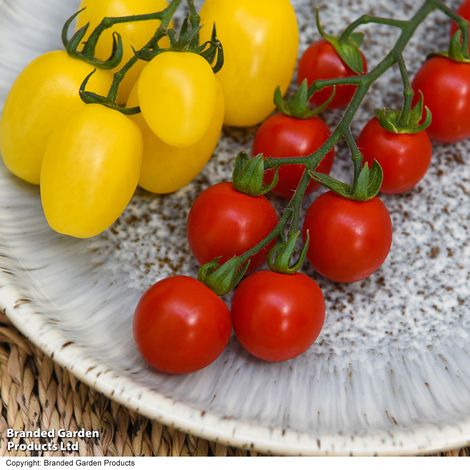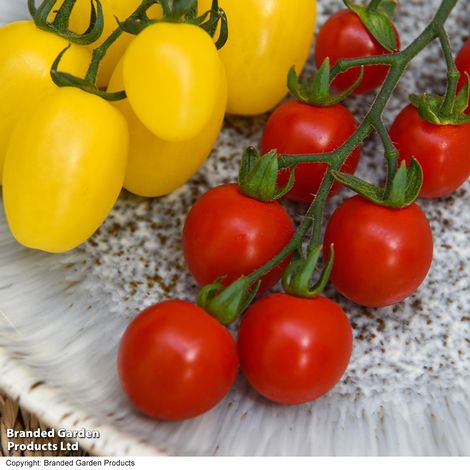Popular 33 others are looking at this right now










Tomato 'Dattolime'Solanum lycopersicum
Half-hardy Annual
A plant that completes its entire life cycle (growth, reproduction, death) in one season.
Can be grown outdoors but requires winter protection from frosts and temperatures below 0C.
£8.99
One of the fruitiest flavoured tomatoes
Large, full trusses for snacking like grapes!
Good disease resistance
![]() Height Up to 180cm (71in)
Height Up to 180cm (71in)
Spread Up to 40cm (16in)
![]() Half-hardy Annual
Half-hardy Annual
![]() patiokitchen gardenconservatorygreenhouse
patiokitchen gardenconservatorygreenhouse
![]() full sun
full sun
You May Also Like
Cordon/Indeterminate
Tomato ‘Dattolime’ is one of the fruitiest flavoured tomatoes we know. A beautiful variety with yellow, almond-shaped fruit, its vibrant colour and sweet flavour, with a balanced 9% brix, make it a delightful addition to any dish. Tomato ‘Dattolime’ is known for its excellent fruit setting, producing split-cluster trusses. It thrives as a strong, compact plant, maintaining a manageable width, suitable for both small gardens and larger plots. The fruit boasts a long shelf life and a superb flavour making it perfect for snacking or adding colour and sweetness to salads. Height: 180cm (71in). Spread: 40cm (16in).
Companion planting: Try growing tomatoes with French marigolds to deter whitefly, and basil, chives or mint to deter aphids and other pests.
Useful links:
How to grow tomatoes How to stop blight
Tomato selector guide Companion Planting
Show Codes
1 x 9cm Potted Plant (KH1954)
Pot up and grow tomato plants on in warm frost free conditions.
Outdoor cultivation: Grow on until large enough to plant outdoors. Wait until all risk of frost has passed before transplanting tomatoes - around early June depending upon location. Gradually acclimatise them to outdoor conditions over a period of 7 to 10 days. Choose a sheltered position in full sun on fertile, reliably moist, well drained soil. Alternatively grow tomatoes in patio bags and containers in good quality compost such as John Innes No. 2.
Greenhouse cultivation: When growing in a heated glasshouse tomato plants may be transplanted at the end of May or when the first flowers are showing, if earlier. Allow 3 plants per growbag, or one per 25cm (10") pot, or plant tomatoes directly into the greenhouse soil. Cordon types should be transplanted at a distance of 60cm (24") apart.
Cordon/indeterminate varieties: Drive a (5ft) cane into the soil adjacent to each plant to support them as they grow, and tie each main stem to its support with soft garden twine.
Bush/determinate varieties: These may require a smaller cane to support the weight of the plant and its fruit. Dwarf bush varieties, such as 'Basket' types, do not require any staking.
Water tomato plants frequently, to keep the compost evenly moist. Feed tomatoes regularly with a high potash plant food once the first truss of fruit has formed. Tomatoes can be harvested as they ripen from July to September.
Cordon/Determinate varieties: Tie the main stems to their supports and remove any sideshoots that develop between the main stem and the leaf stems. Once the plant has produced 6 or 7 trusses, pinch out the top of the main stem. This process of "sideshooting" and "stopping" will increase the availability of light and air movement around the developing fruit, and focus the plants energy on producing a good crop of high quality tomatoes.
Bush tomatoes: May require staking but no sideshooting is required. Dwarf bush varieties, such as 'Basket' varieties, do not require any staking.
Seeds and garden supplies will normally be delivered within the time period stated against each product as detailed above. Plants, bulbs, corms, tubers, shrubs, trees, potatoes, etc. are delivered at the appropriate time for planting or potting on. Delivery times will be stated on the product page above, or in your order acknowledgement page and email.
Orders for packets of seed incur a delivery charge of £2.99.
Orders which include any other products will incur a delivery charge of £6.99.
Where an order includes both packets of seeds and other products, a maximum delivery charge of £7.99 will apply - regardless of the number of items ordered.
Large items may incur a higher delivery charge - this will be displayed in your shopping basket.
Please see our Delivery page for further details, and more information on different charges that may apply to certain destinations.
For more information on how we send your plants please visit our Helpful Guide on plant sizes.






























